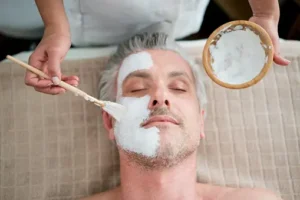How to make a homemade face mask

How to make a homemade face mask – In today’s world, taking care of our skin is more important than ever. While there are countless skincare products available on the market, making your own homemade face mask can be a fun and rewarding experience. Not only can you customize the ingredients to suit your specific skin needs, but you can also ensure that your mask is free from harmful chemicals and additives. EnoughInfo.com

In this article, we will guide you through the process of making a homemade face mask, allowing you to indulge in natural, nourishing skincare.
Creating Your Own Homemade Face Mask: A Guide to DIY Skincare
Step 1:
Determine Your Skin Type and Concerns Before creating a face mask, it’s crucial to understand your skin type and specific concerns. This will help you choose the right ingredients and formulate a mask that addresses your needs effectively. How To Control A Narcissist (Actions to Take)
Step 2:
Select Suitable Ingredients Once you’ve identified your skin type and concerns, it’s time to choose the ingredients for your homemade face mask. Here are some common ingredients and their benefits:
- Oily Skin: Ingredients like clay, witch hazel, lemon juice, and tea tree oil can help control excess oil and reduce shine.
- Dry Skin: Opt for ingredients like avocado, honey, yogurt, and oils (such as almond or olive oil) that provide deep hydration and nourishment.
- Combination Skin: Choose ingredients that balance the skin, such as oatmeal, yogurt, honey, and aloe vera gel.
- Sensitive Skin: Soothing ingredients like cucumber, chamomile, aloe vera, and oatmeal can help calm and reduce irritation.
Read Also: How To Make Money Without A Job (30 Authentic Ways)
Step 3:
Prepare and Mix the Ingredients Once you’ve selected your ingredients, gather them together and prepare them accordingly. This may involve mashing, blending, or mixing the ingredients until you achieve a smooth and consistent texture.
Step 4:
Apply the Face Mask Cleanse your face thoroughly before applying the homemade mask. Using clean hands or a brush, apply an even layer of the mask to your face, avoiding the eye and lip areas. Relax and allow the mask to work its magic for the recommended duration specified in the recipe.
Step 5:
Rinse and Moisturize After the recommended time has passed, rinse off the mask with lukewarm water. Gently pat your face dry with a clean towel. Follow up with your favorite moisturizer to lock in hydration and seal the benefits of the face mask.
Benefits of Homemade Face Masks: There are several benefits to creating your own face masks at home:
- Personalized Ingredients: By making your own face mask, you have full control over the ingredients used. You can tailor the mask to address your unique skin concerns, whether it’s acne, dryness, aging, or dullness. How To Emotionally Connect With A Taurus Man
- Natural and Chemical-Free: Many commercial skincare products contain artificial fragrances, preservatives, and harsh chemicals that may irritate the skin. With homemade face masks, you can use natural, organic ingredients, ensuring that your skin receives only the best nourishment.
- Cost-Effective: Homemade face masks are often more cost-effective than store-bought products. You can use ingredients found in your kitchen pantry or local grocery store, saving you money in the long run.
- Customizable Consistency: Depending on your preference, you can create face masks with various textures, from creamy and thick to light and gel-like. You have the flexibility to experiment and find the consistency that works best for your skin.
Read Also: How To Make Money In Crypto Bear Market
Tips for Making Homemade Face Masks:
Perform a patch test:
Before applying a homemade face mask to your entire face, it’s essential to do a patch test on a small area of your skin. This will help you determine if you have any allergies or sensitivities to the ingredients. How To Paint A Sunset With Acrylics(The Ultimate Guide)
Use fresh ingredients:
Whenever possible, use fresh and high-quality ingredients for your homemade face mask. This will ensure maximum effectiveness and prevent any potential contamination.
Store leftovers properly:
If you have leftover mask mixture, store it in an airtight container in the refrigerator. However, keep in mind that homemade masks may not have a long shelf life, so it’s best to use them within a few days.
Experiment and have fun:
Don’t be afraid to experiment with different ingredients and combinations to find what works best for your skin. Everyone’s skin is unique, so what may work for others may not necessarily work for you. Enjoy the process of creating your own skincare concoctions and discover what your skin loves. How to fix a leaky faucet(The Ultimate Guide)
Practice consistency:
For optimal results, incorporate homemade face masks into your skincare routine on a regular basis. Depending on your skin type and concerns, you may choose to use a face mask once or twice a week.
Be patient:
Results may not be immediate, and it takes time for your skin to show noticeable improvements. Consistency is key, so stick to your skincare routine and give your homemade face masks a chance to work their magic.
Remember, homemade face masks are meant to complement your overall skincare routine and provide a nourishing boost to your skin. They are not intended to replace professional skincare advice or medical treatments. If you have any specific skin concerns or conditions, it’s always best to consult with a dermatologist or skincare professional.
Homemade Face Masks for Various Skin Conditions:
Do you have acne, oily skin, wrinkles, or age spots? Having good skin isn’t just a function of genetics. It also entails following a proper skincare routine that includes cleaning, exfoliating, and hydrating your face.
You may make a DIY face mask with numerous things from your kitchen, such as avocado, oatmeal, honey, turmeric, or banana. From pimples to dull skin, here are some simple remedies to help with common skin issues. How to plant tomatoes in Pots (The Ultimate Guide)
1. Acne treatment mask
Acne is the most frequent skin condition in the United States.
When oil, dead skin cells, and bacteria block pores, zits form, and acne manifests as blackheads, whiteheads, pimples, nodules, and cysts.
However, the protein in egg whites may help eliminate microorganisms on the skin and prevent blemishes.
Ingredients:
2–3 egg whites
Instructions:
- Separate the egg whites from the yolk and place them in a bowl.
- Dab the egg whites on your face with a cotton swab dipped in the bowl.
- Allow the mask to dry for 10 to 15 minutes.
- Apply a moisturizer after washing with a damp cloth.
2. Mask for hyperpigmentation
Post-inflammatory hyperpigmentation refers to darker skin patches caused by acne, aging, or sun exposure.
Dermatological therapies can help diminish hyperpigmentation, although they are generally costly. A DIY turmeric mask can help you save money while also evening out your skin tone and reducing irritation. How To Treat A Burn At Home (All you need to Know)
Ingredients:
1 teaspoon turmeric powder
1 to 2 tablespoons raw honey
Instructions:
- In a mixing dish, combine all of the ingredients to make a paste.
- Massage the paste into your face gently.
- Allow it to rest for 10 minutes before rinsing with warm water.
3. Mask for clogged pores
Exfoliating qualities of oatmeal and baking soda can exfoliate dead skin cells and unclog pores.
Ingredients:
2 teaspoon oatmeal
1 teaspoon baking soda
Read Also: 22 Top Foods For Promoting Heart Health(All You Need to Know)
Instructions:
- In a mixing basin, combine the oatmeal and baking soda. To make a paste, gradually add a few drops of water. https://enoughinfo.com/how-to-make-a-homemade-face-mask
- Allow the paste to dry after gently massaging it over your face.
- Apply a moisturizer after washing with warm water.
4. Mask for oily skin
Oily skin develops when your pores generate an excessive amount of sebum, a natural skin oil.
Oils can block pores and cause acne and irritation. Lemons and bananas can both assist to absorb oil from the skin.
Ingredients:
1 banana
10 mL lemon juice
1 tablespoon of extra virgin olive oil
Instructions:
- In a mixing bowl, mash the banana. To make a liquid paste, combine the lemon juice and olive oil. How To Stop Masturbation (All You Need To Know)
- Place the mask on your face. Allow it to rest for 15 minutes before rinsing with warm water.
5. Mask for dry skin
A moisturizing face mask can aid in the retention of moisture while also alleviating dullness and irritation.
Ingredients:
1/2 cucumber
2 tablespoons aloe vera gel
Instructions:
- Blend the cucumber and blend it with the aloe vera gel.
- Massage the paste into your face gently.
- Allow it to sit for 30 minutes before rinsing with water.
6. Wrinkles concealer
Regular facial treatments can help to decrease the appearance of fine lines and wrinkles while also encouraging tighter, firmer skin.
Avocados and cocoa powder can be used to increase collagen formation, while honey can be used to hydrate and soften skin. https://enoughinfo.com/how-to-make-a-homemade-face-mask
Ingredients:
2 avocados are
1 tablespoon raw honey
2 tablespoons cocoa powder
Instructions:
- In a mixing bowl, mash the avocados and stir in the chocolate powder and honey.
- Massage the mask gently over your face.
- Allow it to sit for 20 minutes before rinsing it with warm water.
Read Also: 11 Ways To Gain Healthy Weight Fast Naturally(2023 Guide)
FAQs & Answers
1, Are homemade face masks effective?
Homemade face masks can provide certain benefits to the skin, such as hydration, nourishment, and soothing effects. However, it’s important to note that homemade face masks may not offer the same level of effectiveness as professional skin care products or medical treatments. Their efficacy may vary depending on the ingredients used and individual skin types. It’s always a good idea to complement homemade face masks with a consistent skincare routine and seek professional advice for specific skin concerns.
2, How often should I use a homemade face mask?
The frequency of using a homemade face mask depends on your skin type and the specific ingredients used. In general, it’s recommended to use a face mask once or twice a week. However, it’s important to pay attention to how your skin responds. If you notice any signs of irritation or dryness, reduce the frequency or switch to a different mask that better suits your skin’s needs.
3, Can I store leftover homemade face mask mixture for future use?
You can store leftover homemade face mask mixture in an airtight container in the refrigerator. However, keep in mind that homemade face masks typically have a shorter shelf life compared to commercial products. It’s best to use them within a few days and discard any leftover mixture that shows signs of spoilage or changes in consistency or odor.
4, Can I combine different ingredients to create my own unique face mask?
A: Absolutely! One of the benefits of homemade face masks is the ability to customize the ingredients based on your skin type and concerns. Feel free to experiment with different combinations of natural ingredients to create your own unique face mask. Just ensure that the ingredients are safe for your skin and perform a patch test before applying the mask to your entire face. How To Treat Scalp Psoriasis Naturally: 10 Home Remedies
5, Can homemade face masks replace professional skincare treatments?
Homemade face masks can be a great addition to your skincare routine, but they are not intended to replace professional skincare treatments. If you have specific skin concerns or conditions, it’s best to consult with a dermatologist or skincare professional who can provide personalized advice and recommend appropriate treatments for your needs.
6, Can anyone use homemade face masks?
Homemade face masks can generally be used by anyone; however, it’s important to consider individual skin sensitivities and allergies. Perform a patch test before applying a homemade face mask to your entire face to check for any adverse reactions. If you have sensitive skin or are prone to allergies, it’s advisable to choose gentle ingredients and consult with a dermatologist if needed.
Remember, the information provided here is for general guidance only. Individual results may vary, and it’s always best to listen to your skin and seek professional advice when necessary.
Read Also: Top Healthy Foods To Eat Everyday(2023 Guide)
Conclusion:
Creating your own homemade face masks allows you to take control of your skincare routine and indulge in natural, personalized skincare. By understanding your skin type, selecting suitable ingredients, and following the proper application techniques, you can pamper your skin and address your specific concerns. Embrace the beauty of homemade skincare and treat your skin to the goodness of nature. Your skin will thank you for the extra care and attention.




